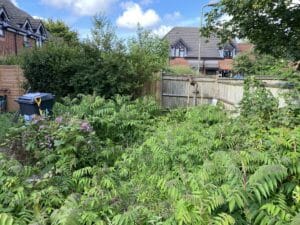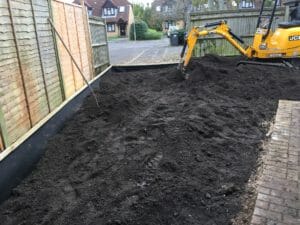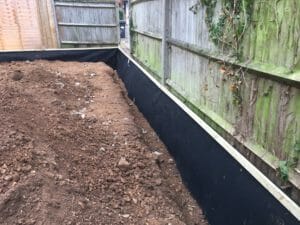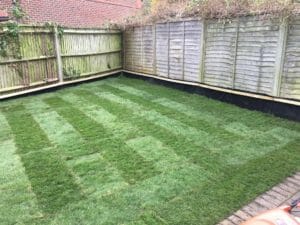Project details:
Staghorn Sumac removal
Client:
Sovereign Housing Association
Type of property:
Residential property
The challenge:
Staghorn Sumac (Rhus typhina) had spread into a Sovereign Housing resident’s garden, out-competing other vegetation and overrunning their outdoor space. This made the garden unusable for the tenant of the housing association, and was a source of concern for both client and tenant.
Attempts had been made by another party to grind-out the stump of the Staghorn Sumac tree that was previously present, and to treat the remaining suckers/roots. When this this proved to be ineffective, the client called PBA Solutions with the aim of restoring the garden to a usable state for the tenant.

The Sumac infested resident’s garden
What is Staghorn Sumac?
Staghorn Sumac (or Stag Horn’s Sumach) is not listed amongst the 36 official invasive Schedule 9 plant species in the UK; however, it is does have invasive characteristics that are even recognised in its origin countries of North America and Canada. The plant can spread via seeds and by sending out new suckers, both of which are aided by our mild British winters.
Whilst an attractive deciduous shrub, with yellow/green flowers, crimson fruit heads and autumnal red leaves, cutting the shrub back can often send it into survival mode where it sends out several suckers (rhizomes) below the lawn to establish new clones. Initially, in the new plant’s (clone’s) first year, it simply sends up a single shoot but over time these increase and become higher, shading out competing plants and easily overwhelming a small garden.
Assessing the problem
Based on the client’s need to quickly resolve the tenant’s problem, PBA Solutions looked at the characteristics of the plant to form the foundation for the remedy. The roots of most Sumac species typically run quite shallow beneath the surface of the ground (typically around 250-300mm in depth), PBA targeted this plant characteristic for the solution.
The solution:
ExcavationFirstly, a 360 micro excavator was used to remove all impacted soil that contained Sumac root to a depth of 500mm. As Staghorn Sumac had also invaded a neighbouring garden and an adjacent roadside verge populated by shrubs, the plants and soil here were also removed.  The excavated land following removal of the Staghorn Sumac PreventionSumac is known for easily spreading from neighbouring properties. To ensure that the solution remained viable, next PBA installed vertical sections of specialist CuTex root barrier to the perimeter fence using 50 x 20mm batons. This is to ensure that any regrowth that might occurring on neighbouring land would be prevented from encroaching on the client property.  CuTex root barrier that has been fixed to the perimeter fence using 50 x 20mm batons. As final precaution, 2.6m x 25m rolls of Cutex where cut to the shape of the garden and laid over the area where soil had been removed. Once positioned, all horizontal and vertical sections were welded together using a specialist heat bond gun. This permeable Cutex tray allows water filter through, whilst blocking any further root growth. The unique qualities of the membrane enabled a reduced dig that minimised both the cost and the amount of landfill waste, delivering an effective and good value solution for the client. N.B. PBA Solutions has over 20 years experience dealing with invasive plant species, including: excavation, the installation and supply of root barrier membrane. Further information about the effective installation of CuTex root barrier and root barrier appropriate for every situation can be found on PBA’s online root barrier store Rootbarrier.store. RemediationFinally, to complete the project, new uncontaminated topsoil was introduced before a lawn was laid using new uncontaminated turf.  The fully remediated garden, including new topsoil and and freshly laid turf. |
Conclusion
The previously unusable garden that was overrun with Staghorn Sumac has been fully remediated and transformed into a space that can now be enjoyed by the resident
Date completed:
November 2021

